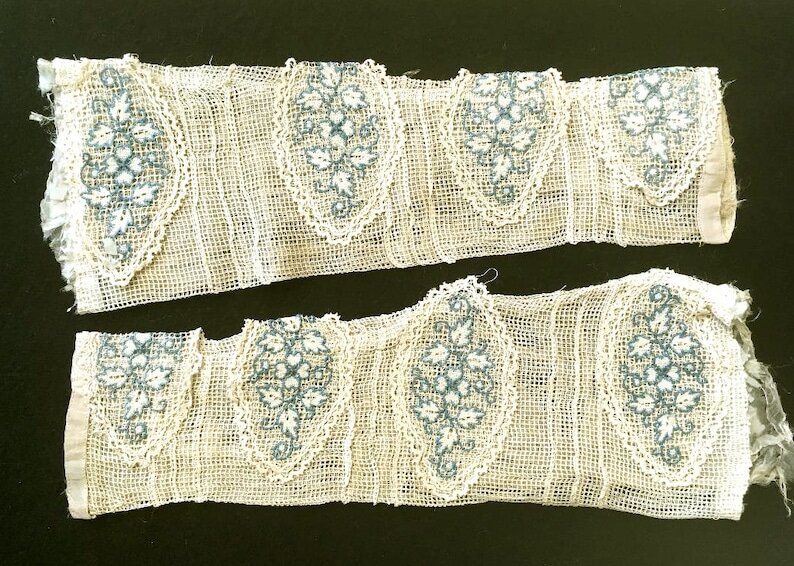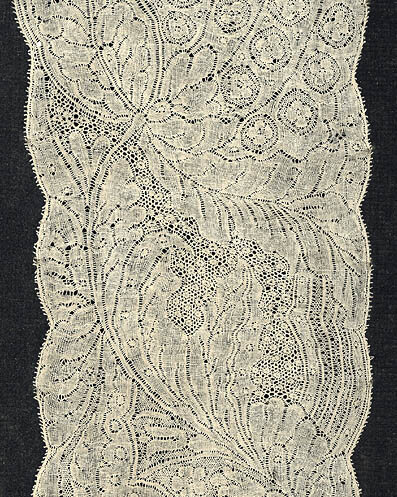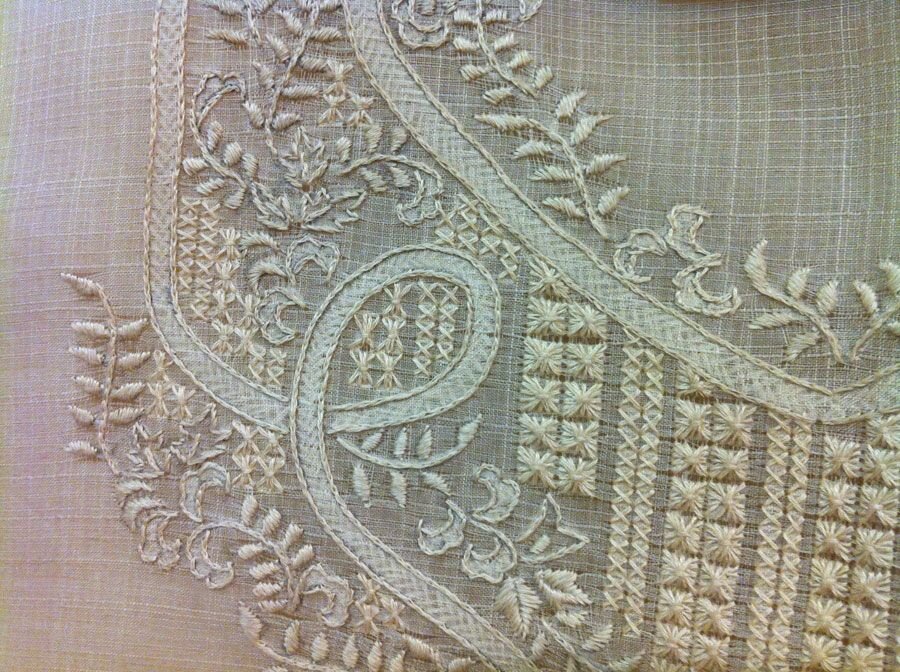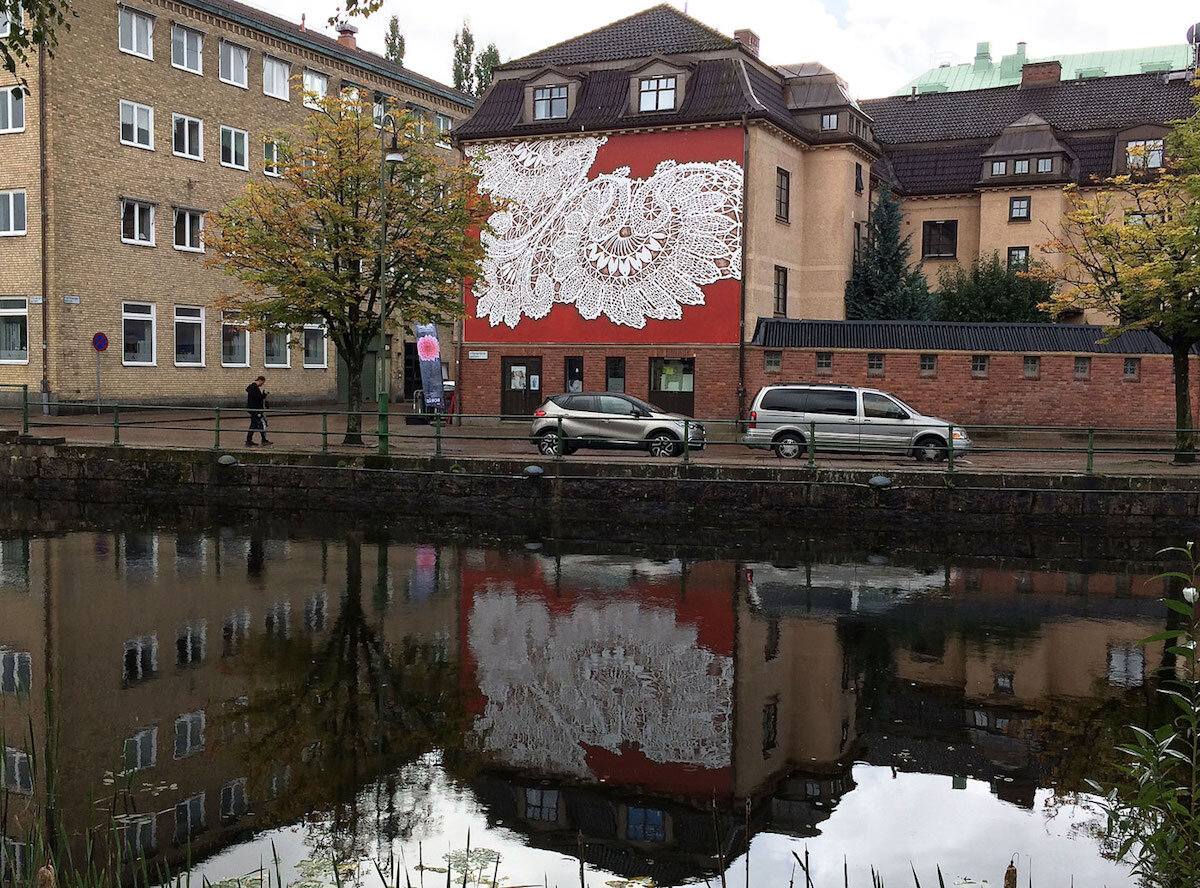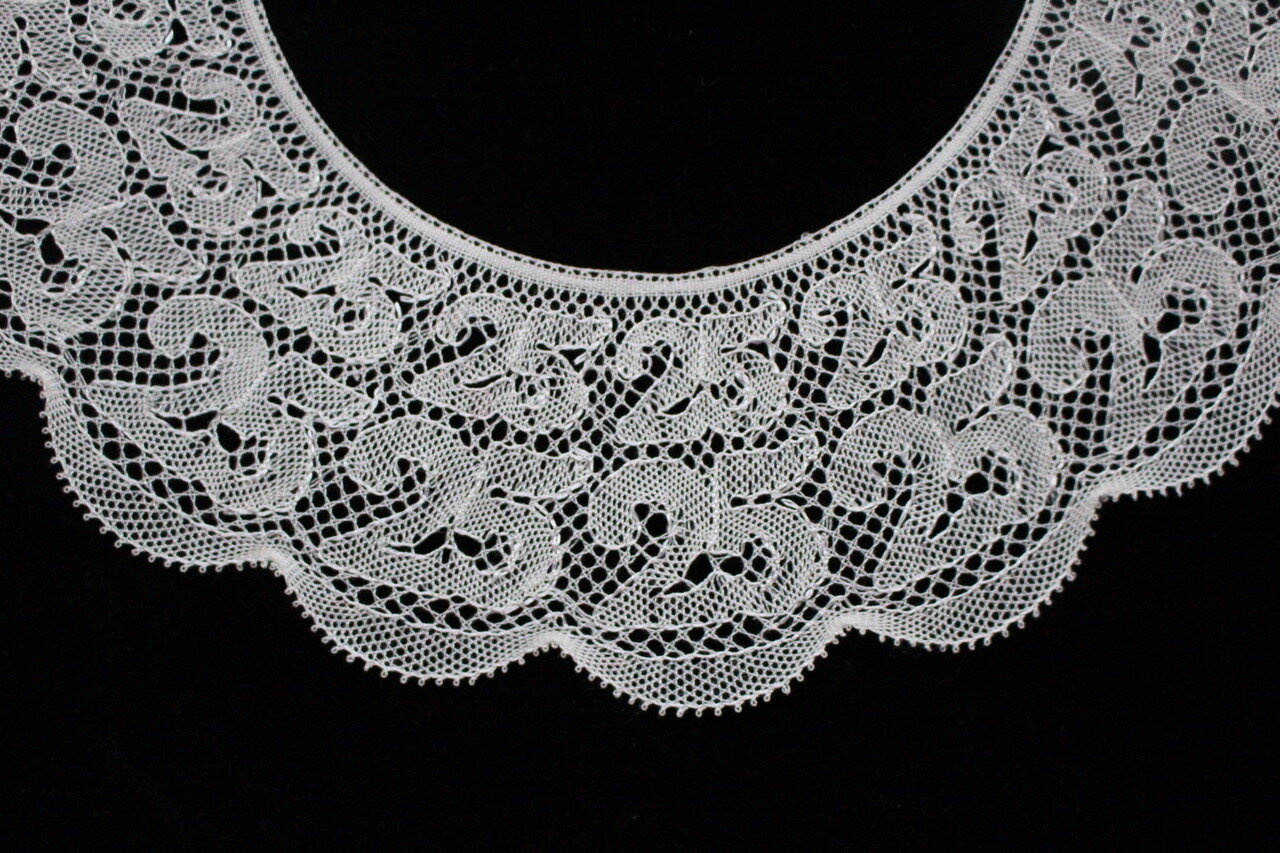
On the breath of angels
by Victoria Thomas
Photo of lace collar for late Justice Ruth Bader Ginsburg courtesy of the artist, Elena Kanagy-Loux.
Why lace?
To modern eyes, lace looks girly, which is to say, fussy. It is, in fact, excruciatingly fussy to make. It’s purely decorative. The French call it frivolite – as in frivolous. Is lace all allure—or is there more?
Being a textile comprised mostly of holes and empty space, lace “neither hides nor heats”, as British Churchman and historian Thomas Fuller observed in his 1662 book, “The Worthies of England.” And yet lace, whether made by bobbin, needle, or crochet hook, has endured for many centuries as one of the most precious textiles in world history, according to Elena Kanagy-Loux, founder of the Brooklyn Lace Guild and Collections Specialist at the Metropolitan Museum of Art’s Antonio Ratti Textile Center.
Soolip chatted recently via Zoom with Kanagy-Loux from her confectionary-pastel pad in Brooklyn to discuss, among other lacey matters, RGB. In 2018, Columbia Law School, where Ruth Bader Ginsburg graduated at the top of her class and became its first tenured woman professor, approached Kanagy-Loux to create a lace collar celebrating the 25th anniversary of RGB’s investiture to the Supreme Court.
The end result is a treasure to behold, incorporating the numeral 25 in two sizes in a repeating pattern rendered in torchon lace, a durable form of comparatively simple bobbin lace that is among the oldest forms found in Europe. Kanagy-Loux had been making lace for about six years when she accepted the challenging task, creating the numerals and scalloped edge with a half-stitch of Egyptian cotton thread, torchon ground for the background and picots (or decorative loops) of the outer edge, and Japanese silk floss for the motif outlines. She estimates that the collar required approximately 300 hours to make.
“Lace is complicated to make, and even more complicated to truly understand,” she says. “It’s always been a medium of contrasts and extremes. For instance, the raw materials needed to make lace are inexpensive, unlike silk wovens, or fine woolens which require an investment in costly yarn. And, to make lace by hand requires little if any equipment, versus a giant loom and the space to set it up and weave. With lace-making, there’s very little overhead, so what gives hand-made lace its value, and what makes it so luxurious, is human time, labor, skill, and love.”
Kanagy-Loux points out that throughout history, skilled lace-makers, typically women, were poorly paid to create anonymous textile masterpieces for royalty, clergy, and the merely wealthy. “This is one of the reasons that I was so honored to create the collar for Justice Ginsburg, who valued women’s labor,” she says.
“Many people felt that Justice Ginsburg’s lace collars were her way of feminizing her power, but actually she was aligning with a much deeper lineage of lace-wearing. We know, for instance, that Queen Elizabeth I loved lace, and she passed sumptuary laws prohibiting anyone else from wearing lace collars that competed with her own in terms of size. Lace was worn in Elizabeth’s time as a clear indicator of wealth, elite status, and visible power.”
Kanagy-Loux adds that although Britain’s Industrial Revolution defined her reign, Queen Victoria refused newfangled, machine-made lace for her own use, instead ordering Honiton lace handmade in Devon for her wedding gown.
It’s also worth remembering that men of means also wore lace for centuries, along with powdered wigs, velvet, and beaucoup bling, to telegraph their status.
More recently, men’s involvement with lace has diminished. In a December, 2016 article titled “Ensuring a Future for Lace” by Dana Thomas, The New York Times noted that by the early 20th century, men were supervising factory-made lace production in European textile centers like Caudry, France while master needle-women stood by to mend any flaws by hand.
Today, the hundred-year old machines with thousands of moving parts continue to produce coveted Chantilly lace, Leavers lace and silk tulle for luxury fashion houses including Chanel, Gucci and Erdem at the Sophie Hallette factory in Caudry, for example.
Even purists will concede that the product is superb. And machine-made, while pricey, is less costly than its hand-made counterpart. So, to choose to hand-craft lace in 2021 may seem a curious decision, with a curious appeal. Allan Chochinov, disruptor, inventor, industrial designer, partner of design network Core77, and Founding Chair of the multi-disciplinary MFA in Products of Design graduate program at the School of Visual Arts in New York City, understands. He’s designed and patented medical and dental devices for Johnson & Johnson and Oral-B among others, and says, “I’m drawn to impossible things.” Among his obsessions: tatting, also known rather unkindly as “poor man’s lace.”
“Yup, I’m a guy who makes doilies,” Chochinov said when Soolip recently Zoom-conferenced with him in New York. “Tatting literally turns nothing into something,” he says. “You have thread, and a shuttle, which is a small, very basic hand-tool. But it’s not an easy skill to pick up. In fact, the price of entry is really high. The first few days are really tough, and the natural mistakes are really, shall we say, expensive. Because you have to pick apart all of these tight knots to get at the correction. What’s maddening is that the actual process is not mysterious. Tatting is no more than making knots and loops and rings and circles.”
Chochinov describes “maniacal dedication” as necessary to mastering this humble skill that generations of grandmothers from Minsk to Manila took for granted in some form of knotted, counted handwork. “You cannot multi-task while you tat. You cannot text your posse while you tat. If you do, there will be disastrous consequences. It requires enormous mindfulness. It’s so singular. So frustrating. I cannot waver. And I totally understand why no one does it.”
The mastery, he notes, rests in the coordination of right and left hands to keep the tension of the thread under perfect control, and an unswerving attention to minute movements. With this in mind, it’s no surprise that Chochinov is also a devotee of speed-cubing.
But here’s what: against all odds, tatting and lace-making of other forms are experiencing an uptick, according to Elena Kanagy-Loux, who founded The Brooklyn Lace Guild in 2016 with a fellow scholar-enthusiasts Kaelyn Garcia and Devon Thein.
“We held our first meeting and were afraid no one would show up,” she recalls. Show up they did, and today the Guild is a virtual gathering-place for lace-makers around the world (even a few men). “Lace for everyone” is the Guild’s inclusive motto.
“Of course, the past year and a half has been so defined by disconnection, emotional and social loss, and isolation of all kinds,” she says. “There is a meditative aspect to doing this work. Many lace-makers express this feeling. It gives us a sense of physical and spiritual harmony.”
While lace-making as a solitary task holds a hypnotic appeal for some, the work has often been a shared activity among groups of women. Chanted rhymes called “tells” were part of how lace-makers in England’s Midlands lace schools kept their pace and counted their pins. Many of the tells recounted domestic violence at the hands of a spouse, and thus the fellowship of lace-making may have afforded vulnerable women some degree of comfort, if not protection.
Further unraveling the complex hide-and-seek of lace history takes us to Turkey, the part of the world where, loosely speaking, many textile authorities trace the origins of all knotted textiles.
For centuries, Turkish women silently communicated much about their private lives through the creation and wearing of oya, a traditional form of knotted needle-lace used to embellish scarves and clothes. A newborn’s garments might be edged with stylized “eyes”, to fend off the evil eye, and a woman might communicate conflict in her marriage with stinging rows of hot red peppers along the hem of her head-scarf. Rows of delicately worked tombstones along the edge of a collar or petticoat telegraph something along the lines of “You’re dead to me,” or perhaps “I’ll take my secret to the grave.”
Traditions exist, rarely discussed, similar to the English lace school “tells”, but with more intent, where the lace-maker silently repeats what might be considered a prayer as she works. Ritual knotting to set intentions and cast spells – even to “bind” a curse -- is recognized in the religious practices of many cultures, from the British Isles to Sicily to West Africa. The Mediterranean and Near East are definitely no exception.
When times are good in the Turkish home, oya edgings of dainty almond-blossom designs, honeysuckle blooms, carnations and tulips trim women’s garments still worn in rural parts of Turkey, especially for weddings and cultural occasions. These knotting techniques may also be called by other names: Rodi lace, Smyrna stitch, bibilla or bebilla, kombo velonya, Nazareth lace, kene, chebka and Armenian lace, and these skills are evident in handwork from Greece, Cyprus, Lebanon, Bulgaria, Armenia, Israel and the historical Palestine area, often expanded into larger formats for doilies, antimacassars and coverings for the arms of upholstered chairs, shawls, and priceless tablecloths and bedspreads, as well as for clerical vestments and altar cloths.
The techniques needed for tig oyasi are straightforward: chain stitch, double-crochet stitch and the basic slip-knot. Newer expressions of oya and its sister techniques may incorporate beads, bling and charms, to appeal to a younger, perhaps Kardashian-influenced shopper.
Oya is often worked into wedge-shaped triangles, and some cultural anthropologists trace this iconic shape – denoting the Sacred Yoni, the Great Mother and female generative source – to ancient Egypt, where the shrouds of mummies were edged with symbolic beadwork in this shape to ensure easy passage through rebirth into the next life. The persistence of this triangular motif moves through history and across cultures as an amulet of feminine protection.
Kanagy-Loux adds, “many of the early European laces were pointed, triangular edgings, hence the names for lace like ‘puntas’ or points, and ‘dentelle’, little teeth.”
Although lace serves no practical purpose, something in its making serves as a vehicle for human community and sanctuary, especially among women. In Malta today, the macramé and crochet made by the patient hands of women often incorporates the distinctive Maltese Cross. Giving new life to this ancient work, an organization called HAJJA, centered in Valletta, Malta, invites women, especially survivors of domestic violence, to join in fellowship in a safe space as they count, knot, and pray. Their prayer goes as follows:
The Lacemaker’s Prayer
“Guide my hands with Speed and Grace,
To weave the intricacies of this Lace,
Let the bobbins weave with Ease,
To make a pattern that will Please.
Let there be Love in its Creation,
And give it Artistry in Inspiration.
May special Care keep threads from Breaking,
And give me Strength for its Making.
Allow this lace to bring Joy and Pleasure,
And give to others a Lifelong Treasure.”
The core of basic lace-making skills are common worldwide, and were often combined to create a piece of lace: needlepoint, bobbin lace, netting, crochet, cutwork, knitting, tatting, crochet, embroidery and appliqué. For example, in 16th and 17th century Italy, artisans made filet lace, originally called lacis, by starting with plain knotted netting made with a small shuttle and gauge rod. The netting was stretched on a frame, and patterns were then needle-woven into the net.
Handmade examples of filet lace are easily distinguishable from machine-made copies by the small, individual “fisherman’s knots” located at each corner of the netting. Whether fanciful or factual, many cultures trace the origins of lace-making back to sturdy mariner’s knots. This metamorphosis from the rugged and sea-faring to the ethereal and dainty is testament to the boundlessness of human ingenuity.
One such account from Burano, the lace-making island located in the Venetian lagoon across from its better-known glass-making sister Murano, relates the story of a fisherman who was tempted by the singing of a siren as he plied the waters. He was already engaged to a mortal woman, and so he resisted the mermaid’s supernatural charms. Impressed by his self-control, the queen of the sirens used her tail to whip up a froth of bubbles which formed a weightless, sparkling wedding veil for his bride-to-be.
This story references an even more ancient myth, Cypriot, then Greek by context, about the emergence of the goddess of love. When her father’s private members were lopped off during a celestial battle overhead, they hit the water and fizzed like an Alka-Seltzer tablet. This plop-plop, fizz-fizz of the sea-foam, called the aphros in Greek, gave the goddess her name: Aphrodite, the foam-born. Inspired by the romance of this story, the legendary needle-workers of Burano devoted centuries to attempting to create a fabric as fragile, exquisite and sublime as that sheaf of mermaid’s bubbles.
Generally, it’s a combination of techniques which produces what most of us think of as lace: frothy, fine, and far removed from its chunkier, heavier, more folksy textile cousins. During our most recent visit to Burano, an elderly woman who sat working outside her lace shop voiced the commonly-held Buranese theory that Arab vessels blown off-course brought the first examples of lace to the island. The precious textile goods were not woven by lonely sailors, she said, but were “della seraglio,” from the harem.
As we chatted in the heat, her visibly arthritic hands whipped threads through the constellation of pins bristling from the small pillow in her lap, whisking out small, inexpensive lace souvenirs for tourists: crosses, butterflies, bookmarks, coaster-sized Venetian carnevale masks and gondolas. Why? She shrugged and said “Tempi cambi” – times change.
She also used the words “tedio” and “noia”, sighing, “Such work requires a lot of boredom.” The original Arabian laces were so remarkable, she explained—so impossible to replicate, to echo doily-dude Allan Chochinov—that church officials had them burned, believing that the stitching could only have been worked by demons, or by a woman possessed.
In spite of this, those patterns were painstakingly deconstructed and reverse-engineered, and lace-making soon found its way into Catholic convents, which was where Nonna Celeste had learned lace-making close to a century ago. Venice became the epicenter of large-scale, prestige lace-making during the Renaissance, and remained so until the Industrial Revolutions of some three centuries later. Fierce competition arose throughout France, England, Belgium, the Netherlands, and many other parts of Europe, and each region developed its own unique vocabulary of stitches, motifs, patterns and combinations.
For example, 16th century Russian lace-makers integrated passementerie, the use of flat, metallic thread, into their work. Lace made for the Tsar and Tsarina set a new global precedent for extravagance, as the artisans entwined silk thread with thin wire of plain or gilt silver, adding pearls and precious gems in styles which recalled Russian icons and the bejeweled holy reliquaries of the Orthodox Church.
Later Russian styles copied folkloric embroidery using bobbin lace. Russian lace-makers often used silk floss in place of humbler linen or cotton, a departure from the general rule that the craft was a modest enterprise. In a juxtaposition that may seem like an oxymoron, entire genres of Russian lace-making and other fine textiles were created and worn by serfs and what could be called a wealthy, land-owning peasant class. In more recent history, Soviet themes including parachutes, Kremlin stars, the hammer and sickle, and depictions of the Lenin Mausoleum have been meticulously rendered in Russian lace.
In an especially poignant twist, lace-making later flourished in Ireland primarily as a means of subsidized income for families in distress during the Great Famine of the 1840s. Lace-making was taught to children in the Dublin workhouses, and lace-making schools were developed as a cottage industry for export sales.
As always, lace served as semaphore for social standing. Upon arrival in America, Irish immigrants were derisively described as “lace-curtain Irish” versus the more lowly “shanty Irish.”
Meanwhile in Meso-America, the origins of lace-making may be attributed to that master weaver, the spider. Throughout the American Southwest, the spider is revered as a wise grandmother, not only the inventor of weaving, but also as the keeper of the cosmic, connective webbing which links all of the realms into a gleaming, wheeling, expanding mandala of the life both seen and unseen.
In an instance of synchronicity, the Greek myths revere the spider as well: the goddess Athena jealously turned a mortal woman, Arachne, into a spider because Arachne’s weaving skills surpassed those of the haughty goddess. Adding further, eternal insult to Athenian injury: Arachne’s name lives on today in the scientific term for spiders, along with their eight-legged relatives, the scorpions and ticks, as Class Arachnida.
As far south as Paraguay, the spider motif resonates with artisans who create the gossamer-fine indigenous lace called Nandutí. Their story is that a young Paraguayan woman became distressed when her lover failed to appear on their wedding day. She desperately searched for him throughout the countryside, only to find his lifeless body on the forest floor at twilight. She knelt beside him and kept a tearful vigil until dawn, opening her weeping eyes at first light to see that his form was wrapped in a shimmering shroud of delicate spider webs. Based on her legend, women sought to create the most ethereal textiles possible with the needles and threads brought to their lands by Spanish missionaries in the mid-16th century.
The feathery whorls and starry clusters of Nandutí are worked with thread finer than a human hair, and are sharply judged on the basis of perfect symmetry. These vaporous works suggest the magnified diatoms and cells captured in the somewhat fanciful drawings of 19th century German biologist Ernst Haeckel – another window, perhaps, into a deeply neurological template that may have guided the hands of generations of lace-makers long before the invention of the microscope.
Nandutí was taking shape as an art form three hundred years before Einstein published of his theory of relativity, yet intriguing correlations emerge. Among native historians and practitioners, it is said that the best examples of Nandutí are so finely worked that they are not visible to the human eye, because their fibers are so energetically charged that they manifest only in the form of light. An indigenous joke suggests that these invisible masterpieces market well to eager museum curators and gullible tourists.
Perhaps the most astonishing expression of lace is called piña weaving or nipis fabric from the Philippines, piña meaning pineapple. Spain colonized the islands between 1565 and 1898, bringing pineapple cultivars, and thus introducing a versatile new plant fiber to a resourceful local textile tradition.
Technically speaking, piña is a loom-woven gauze embellished with intricate embroidery. For centuries, the indigenous culture had used abacá fiber extracted from a native banana species, and quickly adapted their techniques to the fiber of the pineapple leaf, which is similar in texture. The process begins by scraping a pineapple leaf to expose its tough fibers, then knotting the fibers together into strands to be woven into a textile. The artisans brilliantly assimilated European materials and techniques, specifically cotton and linen embroidery, to create this ravishing hybrid which is unique to the Philippines. The fabric quickly became a lucrative item for export, and was notably worn by Queen Victoria as well as other world-dignitaries.
Piña is lightweight, sheer, yet stiffer than European laces. The firmness of the weave makes it ideal for garments requiring a degree of structure, and so it is a favorite for wedding gowns, formal wear, and other items which need to maintain their shape. Piña had nearly disappeared by the middle of the 20th century, but renewed interest assures that this rare form will soon be granted UNESCO World Heritage Status.
Lace is still with us. We don’t need it – we never did, really-- but we still crave it. Depending on context, it’s innocent, sultry, sacramental. Traces of its mythic past linger in the weave, with lace accompanying us on major life-passages: baby’s baptismal gown, bride’s trousseau, widow’s shroud. Worn by a matron, lace is matronly. Worn by a temptress, it’s irresistible.
While fewer and fewer of us buy or wear hand-made lace, its legacy continues to make itself known, often in surprising ways. On September 25, 2021, a remarkable exhibition called P.LACE.S – Looking Through Antwerp Lace opened in Antwerp, Belgium, where the installation leads ticket-holders through five exhibition locations in the city, through January 2, 2022.
The exhibit, developed and researched by Frieda Sorber, curated by Kaat Debo, Wim Merten and Romy Cockx, featuring exhibition design by Ania Martchenko, explores the role of girls and women in both the production and trade of lace, notably an installation at the historic Maagdenhius (Maiden’s House), where orphaned girls learned to sew and make lace.
With the central location as MoMu – Fashion Museum Antwerp, the program reads, “With P.LACE.S, MoMu is starting a unique conversation between historical textile craft and contemporary fashion to look at our history from a different perspective. This creates a visual play between past and present, presenting objects from international collections that have never been shown in Belgium before.”
Contemporary luxury design houses including Iris van Herpen, Azzedine Alaïa, Chanel, Prada and Louis Vuitton are represented in their use of 3D printing and laser cutting to integrate the aesthetic of lace into futuristic couture. Various craft-related activities and lace-making demonstrations are offered, and a handsome, 256-page hardcover companion book, published by Lannoo, is also available, with text in English and Dutch.
Meanwhile, at locations literally scattered around the world, a contemporary Polish installation artist named NeSpoon now considers lace her signature, although she admits that she once “thought lace was old-fashioned, from a grandmother’s dusty apartment.” Wielding a can of spray-paint instead of a bobbin, she covers walls around the world with massive murals depicting classic lace patterns.
Like lace itself, some ask: why? The artist responds, “Why laces? Because in laces there is an aesthetic code which is deeply embedded in every culture. In every lace, we find symmetry, some kind of order and harmony. Isn’t that what we all seek instinctively?”
All other images courtesy of the Metropolitan Museum of Art, Wikimedia Commons, and UNSPLASH.


